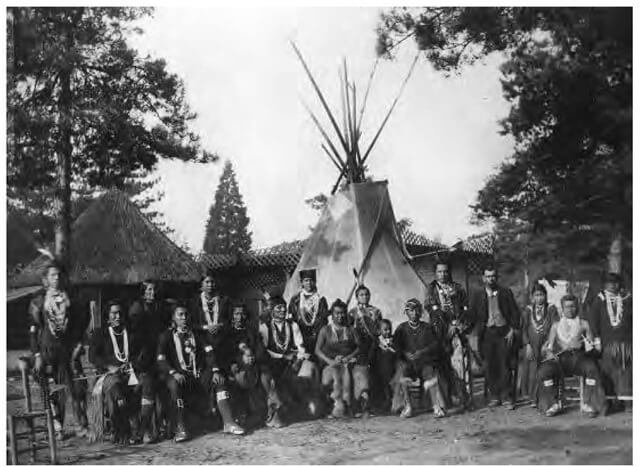Omaha, Nebraska
Omaha is a city in the state of Nebraska and it is the largest city in the state. Omaha is the county seat of Douglas County and is located on an elbow of land that extends into the Missouri River and its historic waterway, which was once used by early explorers to navigate throughout North America.
Omaha is a major rail and trucking centre as well as an important economic centre for the entire Midwest.
Omaha was named after a Native American tribe.
Omaha, Nebraska was named after the Native American tribe of the same name. The word Omaha (actually Umoⁿhoⁿ or Umaⁿhaⁿ) in the Omaha language means “Upstream People” or “Against The Current.”

Brief History of Omaha
Omaha was founded in 1854 by a group of settlers led by former steamboat captain John D. Miller. The city was named after the Omaha tribe, one of the most powerful tribes in Nebraska as well as one of the largest Native American groups in North America.
The city quickly grew due to its location along the Missouri River, making it an ideal spot for trade and business development.
In 1865, Omaha became a stop on the famous Oregon Trail, a trail used by pioneers travelling westward from Independence, Missouri to Oregon City or Portland.
This made Omaha an important settlement for people looking for work or new opportunities further westward from their homes in Iowa and Illinois; however, this also caused tension between natives like Indians who lived in nearby tribes such as Pawnees who didn’t want these immigrants taking over their land.
In 1872, Omaha’s population reached 20,000 people, making it the largest city in Nebraska at that time.
Omaha went through many changes during its history, including being a major railroad hub for decades until the 1960s when modern technology made trains less important.
Today, Omaha is still known as a centre for railroads but also has become home to many other industries including finance and medicine.
Omaha Flag
The Omaha flag was designed by Native American artist and activist, Frank Black Horse. The flag is a symbol of the Omaha tribe, which lived in present-day Nebraska and South Dakota.
The design represents their history, culture, and beliefs.
Geography Of Omaha
The geography of Omaha, Nebraska is characterized by its riverfront position alongside the Missouri River.
The city is located in the Midwestern United States at an elevation of 20 feet above sea level. The city is traversed by several major highways that link it to neighbouring cities.
Omaha is bounded by three rivers: Elkhorn Creek on the West; Papillion Creek on the North and South; and Platte River on the East.
The city is built on bluffs composed of sandstone and limestone that rise above the river’s floodplain. Most of Omaha’s suburbs lie on one of these bluffs, as do several important business districts such as downtown Omaha.
Sister Cities of Omaha
| City/Province | Country |
| Braunschweig, Lower Saxony | Germany |
| Shizuoka | Japan |
| Šiauliai | Lithuania |
| Xalapa, Veracruz | Mexico |
| Naas, County Kildare | Ireland |
| Yantai, Shandong | China |
| Carlentini, Sicily | Italy |
Facts About Omaha
- Omaha is home to the Largest Indoor Desert & the Largest Indoor Rainforest.
- Omaha is generally divided into six geographic areas: Downtown, Midtown, North Omaha, South Omaha, West Omaha, and East Omaha.
- Omaha is the 29th largest city in the U.S., with a population of 486,051.
Climate Of Omaha
The climate of Omaha is humid continental, with four distinct seasons: spring, summer, autumn and winter.
The high temperature during this time of year is around 63 degrees Fahrenheit, while the low is usually around 32 degrees Fahrenheit.
Spring is mild but rather short; it lasts only a few weeks before temperatures start rising again. The average daily high temperature in May ranges between 68 and 77 degrees Fahrenheit, While lows range between 42–48 F.
The winter temperatures drop below zero degrees Fahrenheit.
The record high temperature was 106 degrees Fahrenheit, which occurred on July 24th, 2001. The record low temperature was -34 degrees Fahrenheit, which occurred on January 12th, 1888.

Economy Of Omaha
Omaha is a major centre for the insurance industry, with several Fortune 500 companies having headquarters in the city.
The most notable is Mutual of Omaha, which was founded in Omaha in 1883 and continues to be headquartered there today. Other companies based in Omaha include ConAgra Foods, First National Bank of Omaha, Kiewit Corporation and Union Pacific Railroad.
The largest employer in the city is Berkshire Hathaway, Inc., which has been based out of Omaha since its inception in 1886.
The healthcare industry is another important part of Omaha’s economy. In recent years there has been considerable growth in research being conducted at various institutions throughout the city, including Creighton University School of Medicine, Nebraska Methodist College, HealthEast Care System and Storz Instruments Incorporated.
Conclusion
Omaha is a great place to visit, but it’s even better if you live here. The city has a rich history and beautiful architecture. There are many museums, parks and other attractions that highlight Omaha’s past as well as its present.
Want to visit Omaha, visit the official VisitOmaha website.


